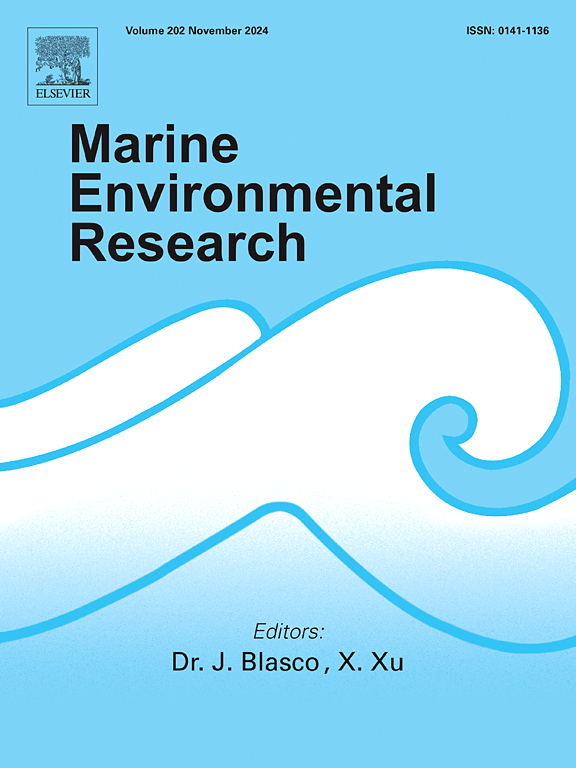Unveiling hidden Flows: Tracing submarine groundwater discharge in Punnakayal Estuary coastal region, Tamil Nadu, India, through radon (222Rn) and GIS topology
IF 3
3区 环境科学与生态学
Q2 ENVIRONMENTAL SCIENCES
引用次数: 0
Abstract
The precise quantification and understanding of submarine groundwater discharge (SGD) pose significant challenges, despite its critical role in the dynamics of coastal ecosystems. The present study conducted in the Punnakayal Estuary, Tamil Nadu, India presents an innovative approach to unveil hidden flows of groundwater discharge using a combination of radon (222Rn) tracing and Geographic Information Systems (GIS) Topology. Radon (222Rn), a radioactive gas that occurs naturally acts as a unique tracer for SGD due to its ability to partition between groundwater and surface water. In the present study, radon concentrations were measured systematically across the estuarine environment to identify areas of SGD influence. The data were then integrated into a GIS framework, where spatial topology was employed to analyze the intricate connectivity between surface water bodies, subsurface groundwater and SGD pathways. The results reveal a comprehensive view of SGD dynamics within the Punnakayal Estuary with the fresh SGD of 4.52 × 10−7 m3/s through GIS modelling approach. Notably, the combination of radon tracing and GIS topology unveils previously concealed pathways of groundwater discharge. High-flow accumulation zones indicative of SGD was identified, shedding light on the spatial distribution of this vital hydrological process. SST of the region was also calculated to validate this approach. This research contributes to our understanding of coastal hydrogeology and ecosystem health in the Punnakayal region, with implications for sustainable coastal management and resource conservation. The integrated approach of radon tracing and GIS topology offers a robust methodology applicable to similar coastal environments globally, addressing the challenges associated with the hidden flows of submarine groundwater discharge. By uncovering the intricate subsurface interactions between groundwater and estuarine systems, was not only advances scientific knowledge but also provides valuable understandings to protect and preserve the delicate balance of coastal ecosystems.
揭示隐藏的流动:通过氡(222Rn)和GIS拓扑跟踪印度泰米尔纳德邦Punnakayal河口沿海地区的海底地下水排放
尽管海底地下水排放(SGD)在沿海生态系统动力学中起着关键作用,但其精确量化和理解仍面临重大挑战。本研究在印度泰米尔纳德邦Punnakayal河口进行,提出了一种利用氡(222Rn)追踪和地理信息系统(GIS)拓扑相结合的创新方法来揭示地下水排放的隐藏流动。氡(222Rn)是一种天然存在的放射性气体,由于它能够在地下水和地表水之间划分,因此可以作为SGD的独特示踪剂。在本研究中,系统地测量了整个河口环境的氡浓度,以确定SGD影响的区域。然后将数据整合到GIS框架中,在该框架中,空间拓扑被用于分析地表水体、地下地下水和SGD路径之间复杂的连通性。通过GIS建模方法,揭示了新鲜SGD为4.52 × 10−7 m3/s时Punnakayal河口SGD动态的全貌。值得注意的是,氡追踪和GIS拓扑的结合揭示了以前隐藏的地下水排放途径。确定了指示SGD的高流量积聚带,揭示了这一重要水文过程的空间分布。计算了该地区的海表温度,验证了这一方法。本研究有助于我们对Punnakayal地区沿海水文地质和生态系统健康的认识,对沿海可持续管理和资源保护具有重要意义。氡追踪和GIS拓扑的综合方法提供了一种适用于全球类似沿海环境的强大方法,解决了与海底地下水排放隐藏流相关的挑战。通过揭示地下水和河口系统之间复杂的地下相互作用,不仅推进了科学知识,而且为保护和保持沿海生态系统的微妙平衡提供了有价值的理解。
本文章由计算机程序翻译,如有差异,请以英文原文为准。
求助全文
约1分钟内获得全文
求助全文
来源期刊

Marine environmental research
环境科学-毒理学
CiteScore
5.90
自引率
3.00%
发文量
217
审稿时长
46 days
期刊介绍:
Marine Environmental Research publishes original research papers on chemical, physical, and biological interactions in the oceans and coastal waters. The journal serves as a forum for new information on biology, chemistry, and toxicology and syntheses that advance understanding of marine environmental processes.
Submission of multidisciplinary studies is encouraged. Studies that utilize experimental approaches to clarify the roles of anthropogenic and natural causes of changes in marine ecosystems are especially welcome, as are those studies that represent new developments of a theoretical or conceptual aspect of marine science. All papers published in this journal are reviewed by qualified peers prior to acceptance and publication. Examples of topics considered to be appropriate for the journal include, but are not limited to, the following:
– The extent, persistence, and consequences of change and the recovery from such change in natural marine systems
– The biochemical, physiological, and ecological consequences of contaminants to marine organisms and ecosystems
– The biogeochemistry of naturally occurring and anthropogenic substances
– Models that describe and predict the above processes
– Monitoring studies, to the extent that their results provide new information on functional processes
– Methodological papers describing improved quantitative techniques for the marine sciences.
 求助内容:
求助内容: 应助结果提醒方式:
应助结果提醒方式:


